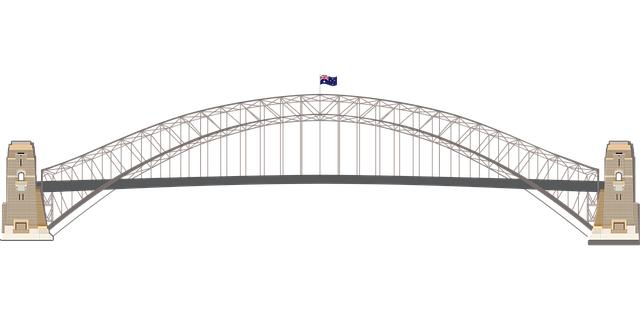
 |
|---|
 |
|---|
For a rod under tension,
Rod cross-sectional area = A meter2 Tensile force = F Meter Tensile stress = P = F/A Pascal
Tensile strain is stretching, and is measured as a fractional change in length. For a rod under strain,
Rod length = X Meter Rod change in length = x Meter Strain = s = x/X Dimensionless
The tensile modulus is resistance to strain, and can be thought of as stiffness. This is a form of Hooke's law. For a rod under stress,
Stress on the rod = P Pascals Rod tensile modulus = T Pascals Rod strain = s = P/T Dimensionless
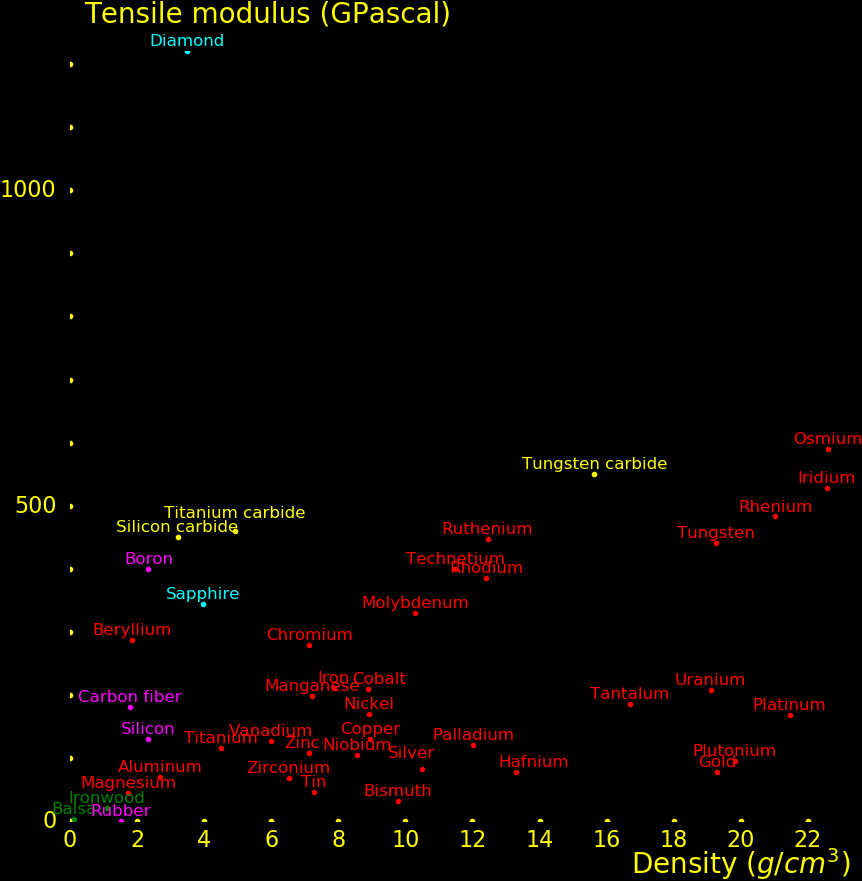 |
|---|
A material's "tensile strength" is the maximum tensile stress it can take before breaking.
Tensile strength = tbreak Newton/meter2 (Pascals) Cross-sectional area = A meter2 Breaking force = Fbreak = tbreak A Newton
A material's "tensile yield strength" is the maximum stress it can take before deforming irreversibly. For metals, the yield strength is usually 3/4 of the tensile strength, and for wood, the yield strength is only slightly less than the tensile strength.
For engineering, we focus on yield strength rather than tensile strength.
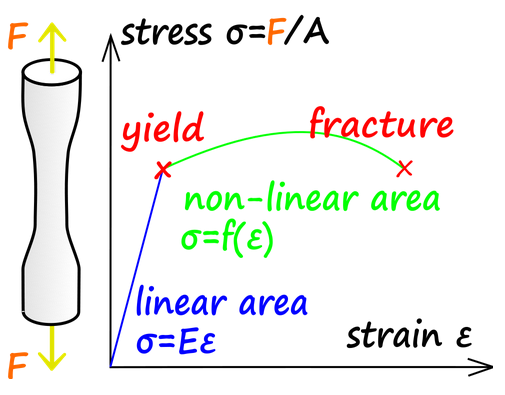 |
|---|
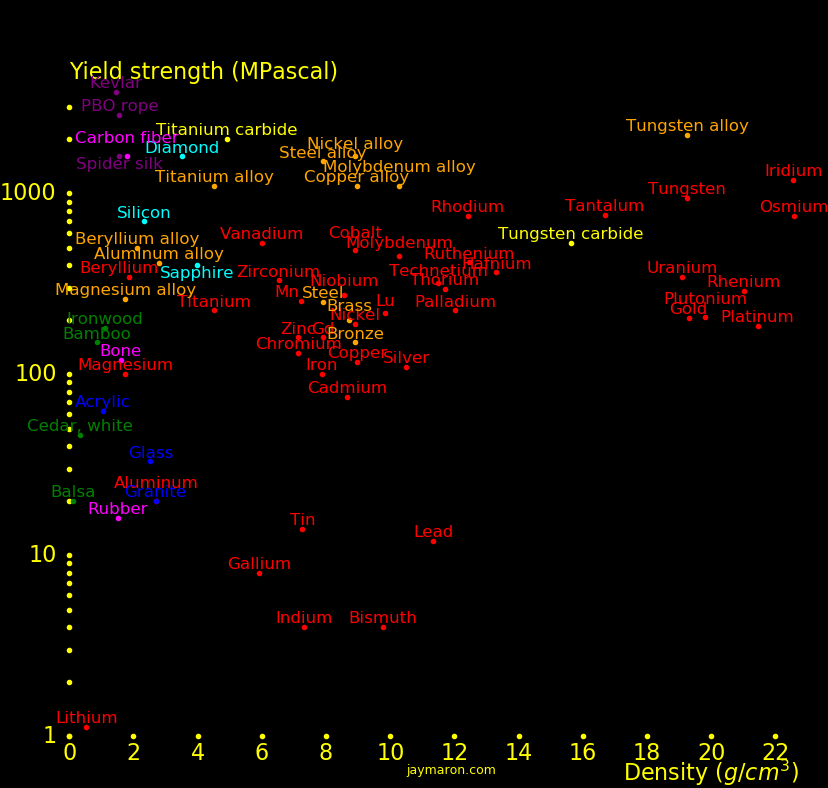 |
|---|
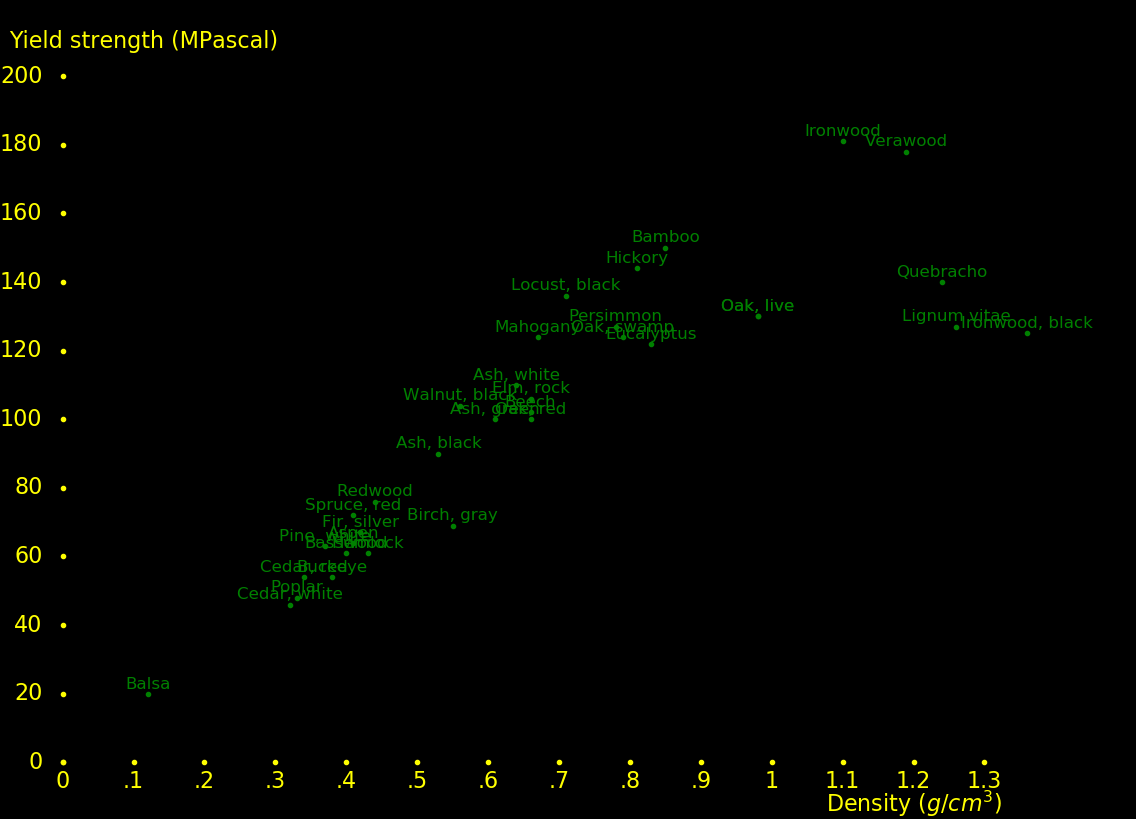 |
|---|
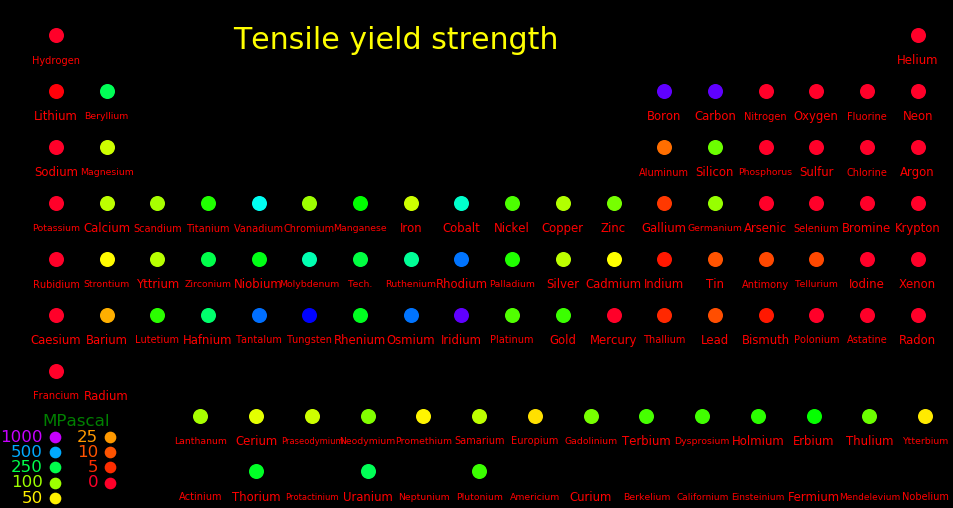 |
|---|
A material's "tensile yield strain" is the maximum strain it can take before yielding. For metals, the value varies widely.
Alloying a metal doesn't change the tensile modulus, but it improves yield strain.
Yield strength = t Pascals Tensile modulus = T Pascals Yield strain = S = t/T Dimensionless
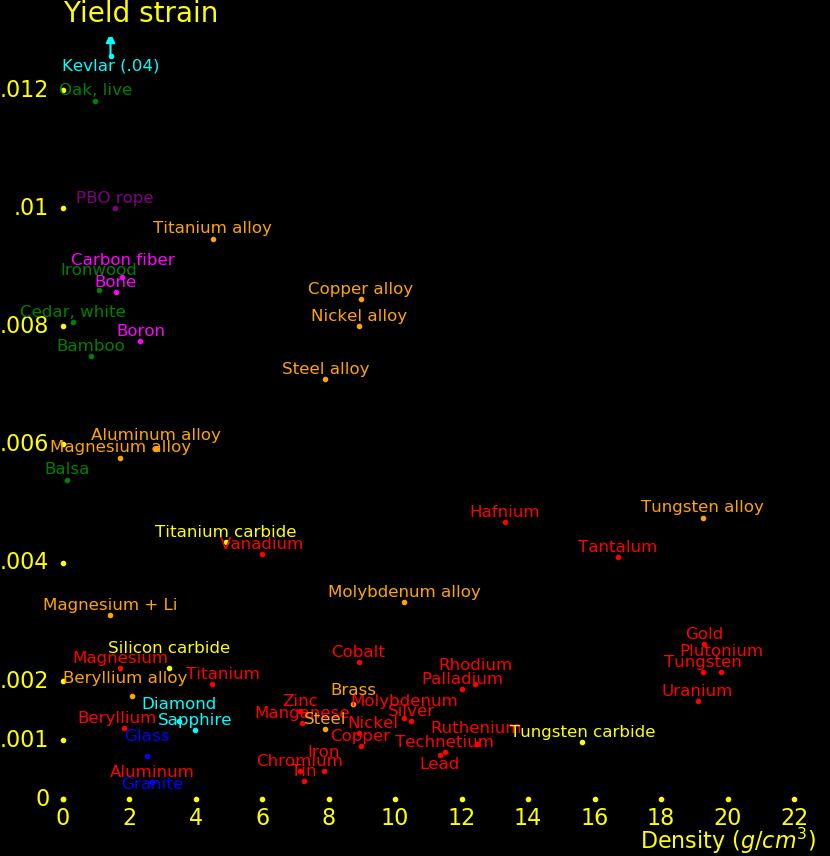 |
|---|
Density = ρ kg/meter2 Cross-sectional area = A meter2 Force = F Newton Tensile stress = P = F/A Pascals Tensile modulus = T Pascals Tensile yield stress = t Pascals Tensile breaking stress= tbreak Pascals Strain = s = P/T Dimensionless Tensile yield strain = S = t/T Dimensionless Tensile energy/volume = evol = ½ T s2 Joule/meter3 Tensile energy/mass = e = ½ T s2/ρ Joule/kg
The table shows the "strong metals", the metals with good strength/density.
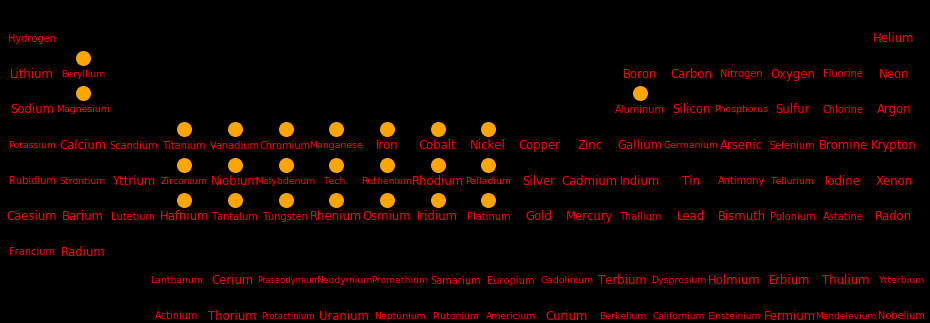 |
|---|
For bridges, what counts is strength/density.
For wood and for the strong metals,
Tensile modulus / Density ~ 25 MJoules/kg
Beryllium is an exception, with a value of 137 MJoules/kg.
The plot shows the tensile modulus divided by density.
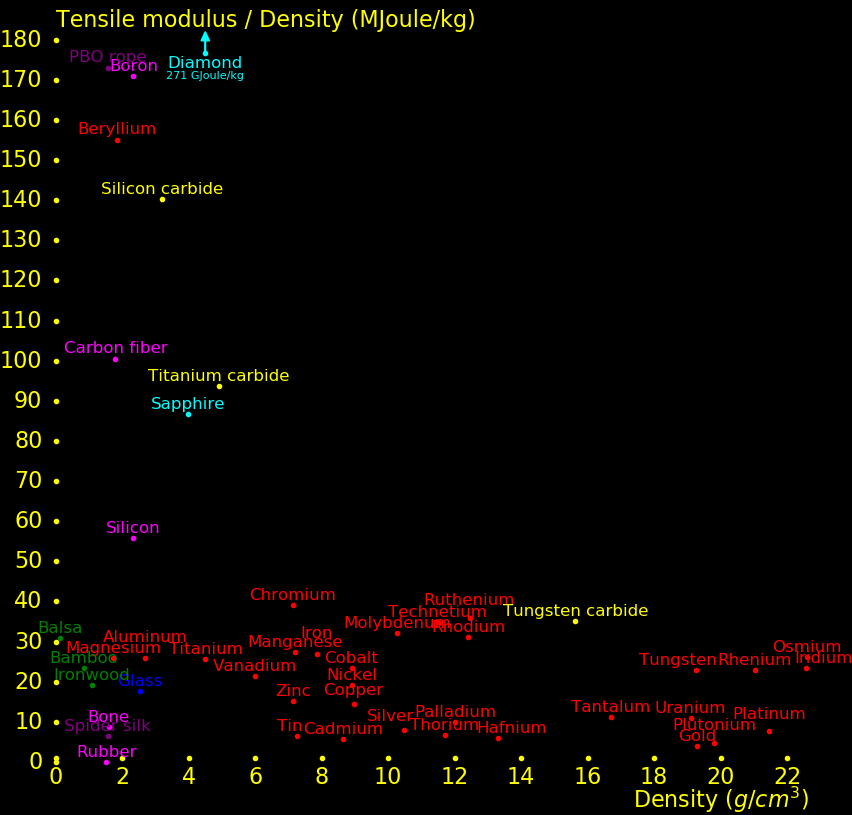 |
|---|
For many applications, the measure of the quality of a material is the elastic energy/mass it can take before yielding. For this, a material should have a large tensile modulus and a large yield strain.
Tensile modulus = T Tensile yield strength = t Tensile yield strain = S Density = ρ Tensile energy/volume = evol = ½ T S2 Joule/meter3 Tensile energy/mass = e = ½ T S2/ρ Joule/kg
The best materials are polymers such as Kevlar.
Alloys outperform pure metals. The best alloy is titanium alloy.
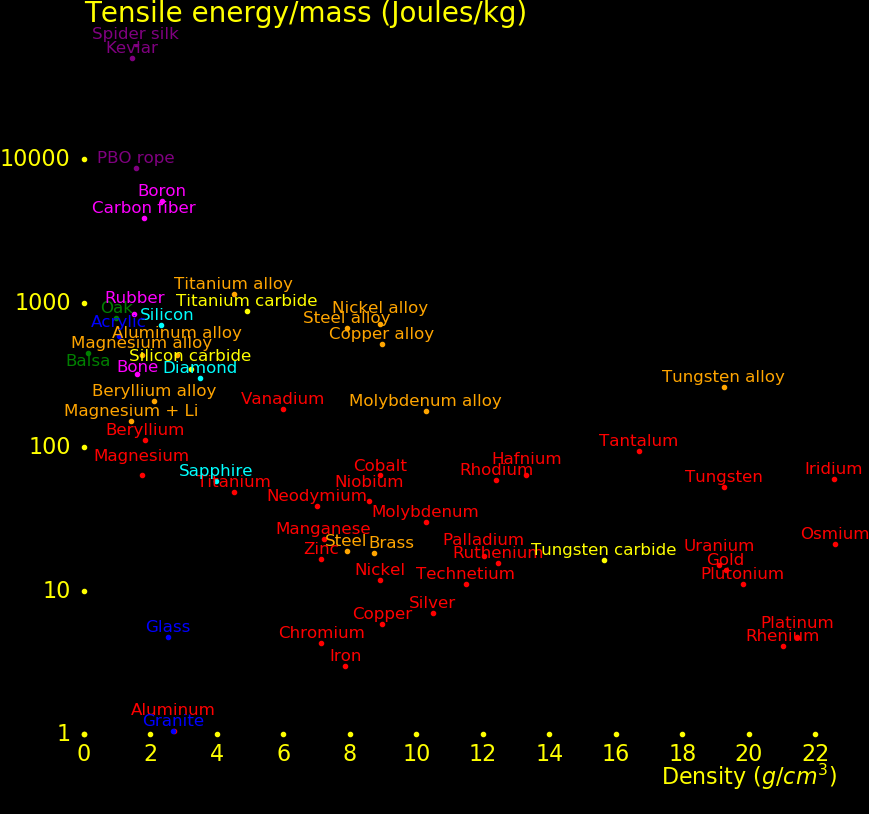 |
|---|
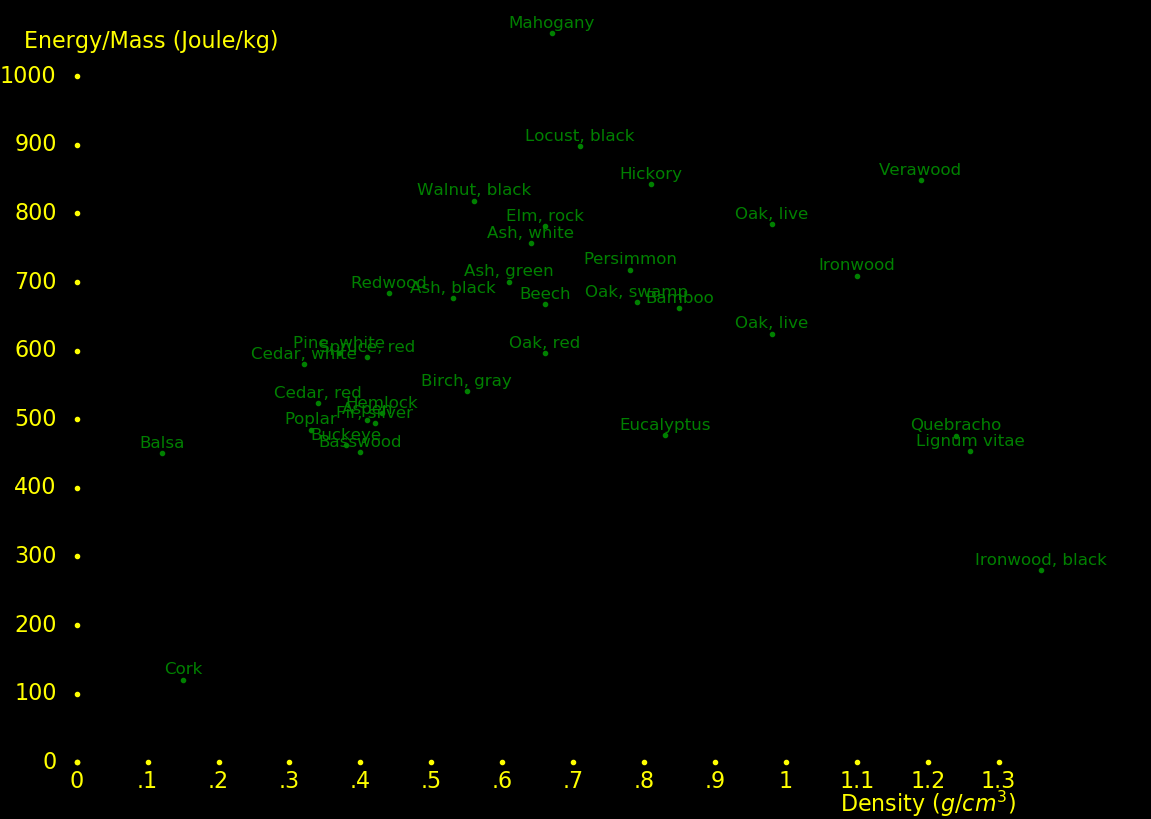 |
|---|
The types of deformation are tension, shear, and bulk compression.
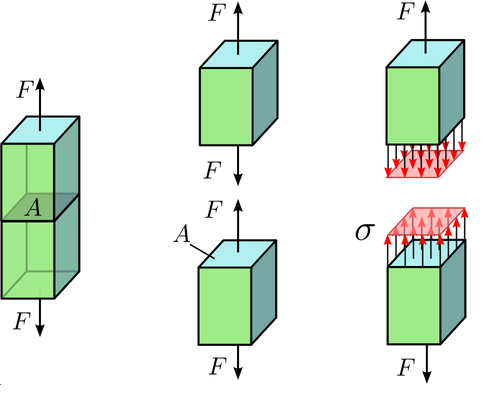 |
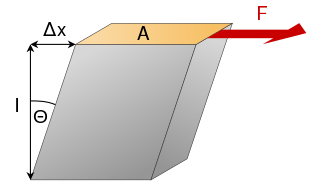 |
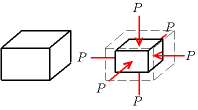 |
|---|---|---|
A wire shortens when stretched and widens when compressed.
dX = Fractional increase in length of the wire dY = Fractional decrease in diameter of the wire PoissonRatio = dY / dX
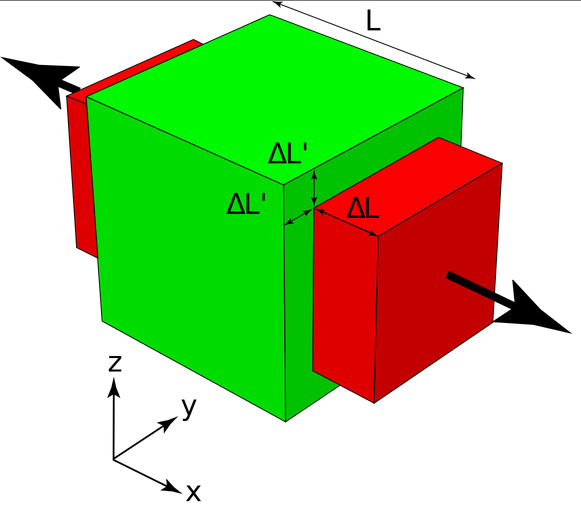 |
 |
|---|---|
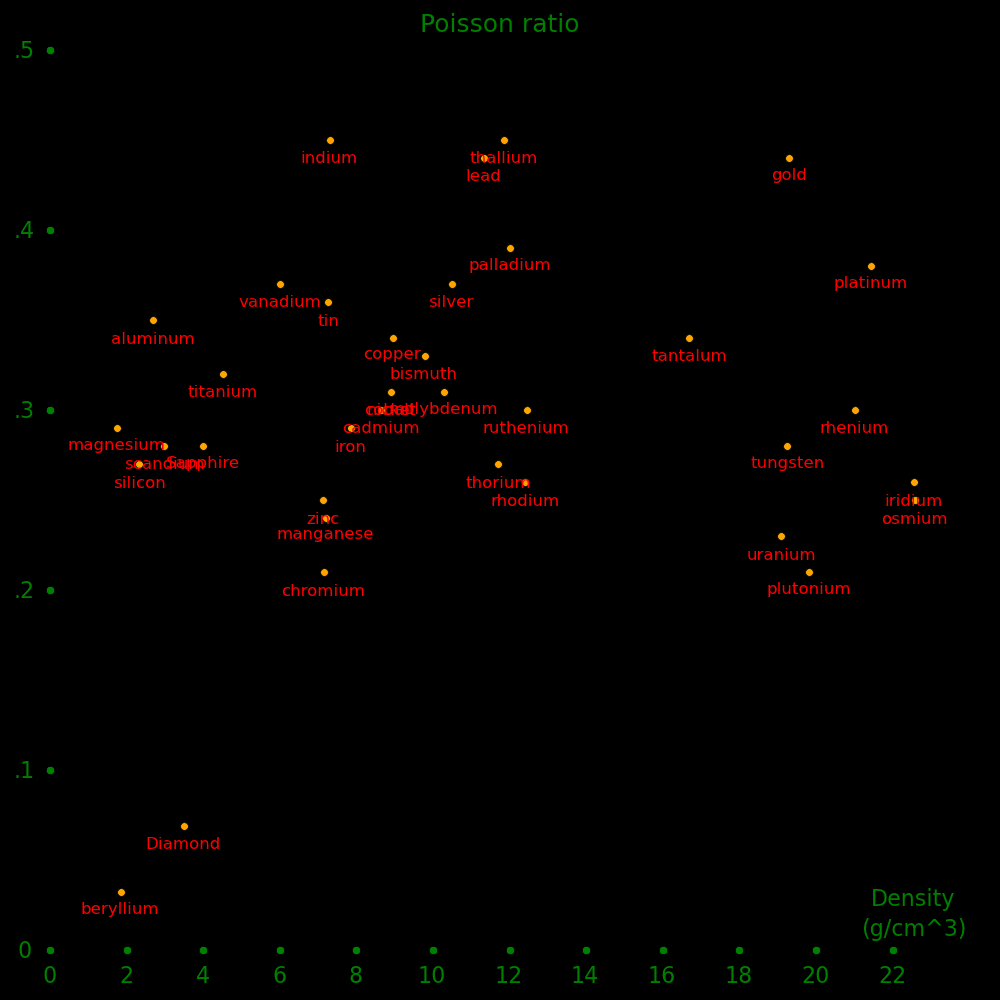 |
|---|
For an isotropic material, the tensile, shear, and bulk moduli are related through the dimensionless Poisson ratio.
Tensile modulus = T Pascals Shear modulus = Tshear Pascals Bulk modulus = Tbulk Pascals Poisson ratio = U dimensionless T = 2 (1 + U) Tshear = 3 (1 - 2U) Tbulk
For beams, the types of stresses are:
 |
 |
 |
|---|---|---|
Tensile strength relates to the strength of wires.
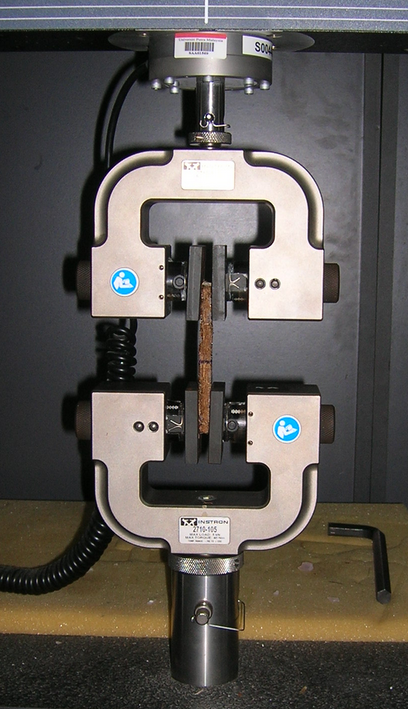 |
|---|
Tensile yield strength = t Newton/meter2 (Pascals) Cross-sectional area = A meter2 Yield force = F = tA Newton
 |
|---|
For bending, the yield force of a beam is determined by the shear yield strength.
Beam length = X meter Beam width = Y meter Beam height = Z meter The force is in the Z direction Beam yield force = f Newton Tensile yield strength = t Pascal Poisson ratio = U dimensionless Shear yield strength = tshear = ½ t / (1+U) Pascal Bending yield force = f = ⅔ tshear Y Z2 / X
Z matters more than Y. If you have a beam with a 2x4 cross section, it's best
to align the beam so that Z=4 and Y=2, rather than with Z=2 and Y=4.
Short columns fail by crushing and long columns fail by buckling.
Crushing strength is determined by bulk yield strength.
Bulk yield strength = tbulk Newton/meter2 (Pascals)
Cross-sectional area = A meter2
Crushing force = F = bbulkA Newton
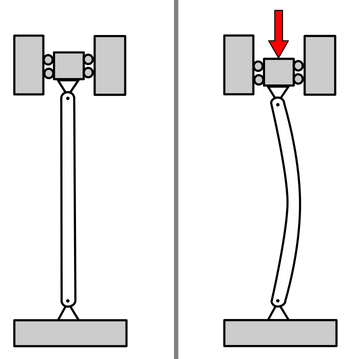 |
|---|
Long columns fail by buckling, and strength is determined by tensile yield strength.
For a column that is cylindrical and hollow,
Column length = L
Column outer radius = R
Column inner radius = r
Column boundary factor = K dimensionless
= .5 if both ends are fixed
= 2 if one end is fixed and the other end is free to move laterally
= 1 if both ends are pinned (hinged and free to rotate)
= .699 if one end is fixed and the other is pinned
Tensile yield strength = t
Buckling force = f = ½ π3 t (R4-r4) / (K L)2
If a column's buckling limit is equal to its squashing limit, and if r=0,
R/L = (K/π) (tbulk/t)1/2
Beam length = L Beam radius = R Beam tension strength ~ R2 Beam bending strength ~ R3/L Beam buckling strength ~ R4/L2
For beams and columns, the lower the density, the better.
For a square beam with Y=Z,
Density = ρ Mass = M = X Y Z ρ Beam yield force = F = ⅔ s Y Z2 / X = ⅔ S M3/2 ρ-3/2 / X5/2
At fixed length and mass, the measure of quality is t/ρ3/2.
For a cylindrical column,
Density = ρ Mass = M = π R2 L ρ Column effective length= K = 1/2 dimensionless For a column that's fixed at both ends Column buckling force = F = ½ π3 t R4 / (K L)2 = ½ π3 t M2 ρ-2 / (K2 L4)
At fixed length and mass, the measure of quality is t ρ-2.
The measure of merit depends on the application. If force/mass is what counts, then the measure of merit is
Tensile yield strength / Density Beam under tension Tensile yield strength / Density3/2 Beam under shear Tensile yield strength / Density2 Beam under compression
For many applications, the measure of merit for a material is energy/mass, where "energy" is the maximum elastic energy the material can take before breaking. This applies to things like racquets, aircraft, and swords. The cases are:
Case Measure of merit Tension Energy / Mass Shear Energy / Mass / Density1/2 Compression Energy / Mass / Density
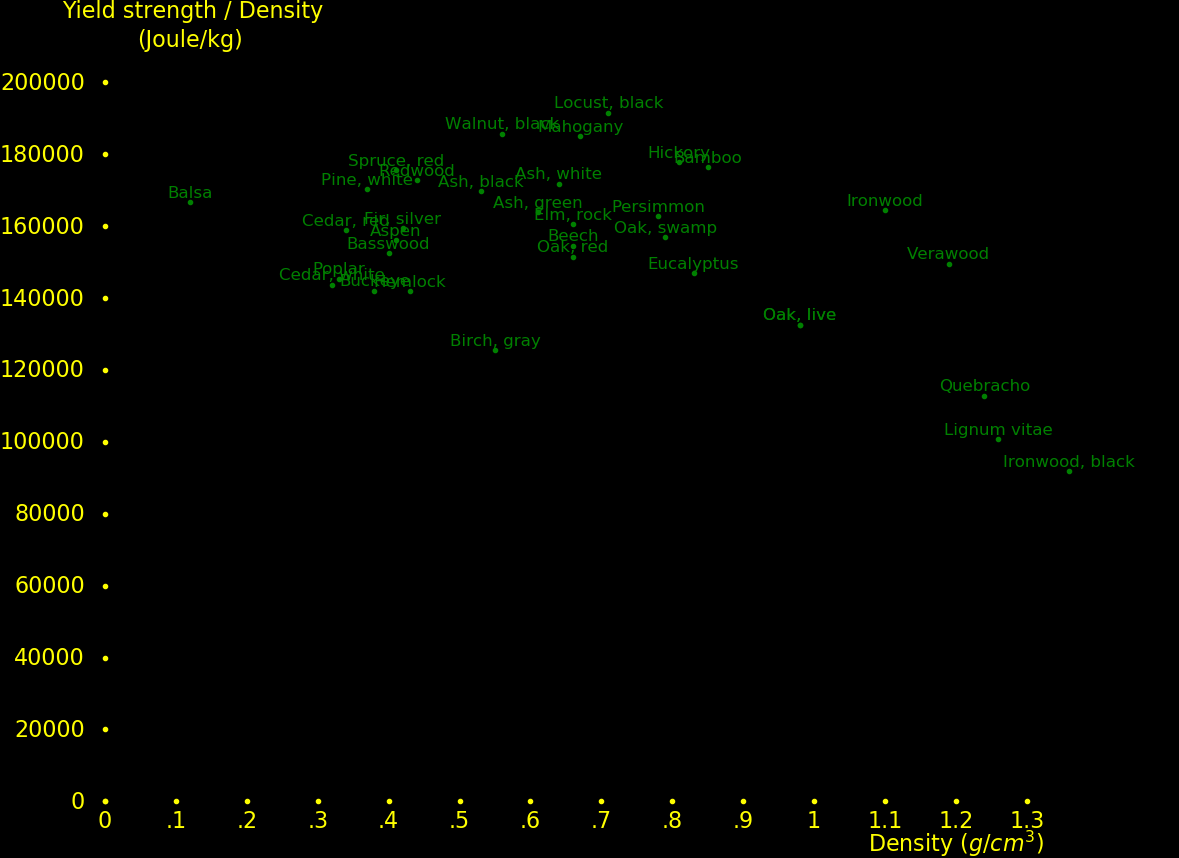 |
|---|
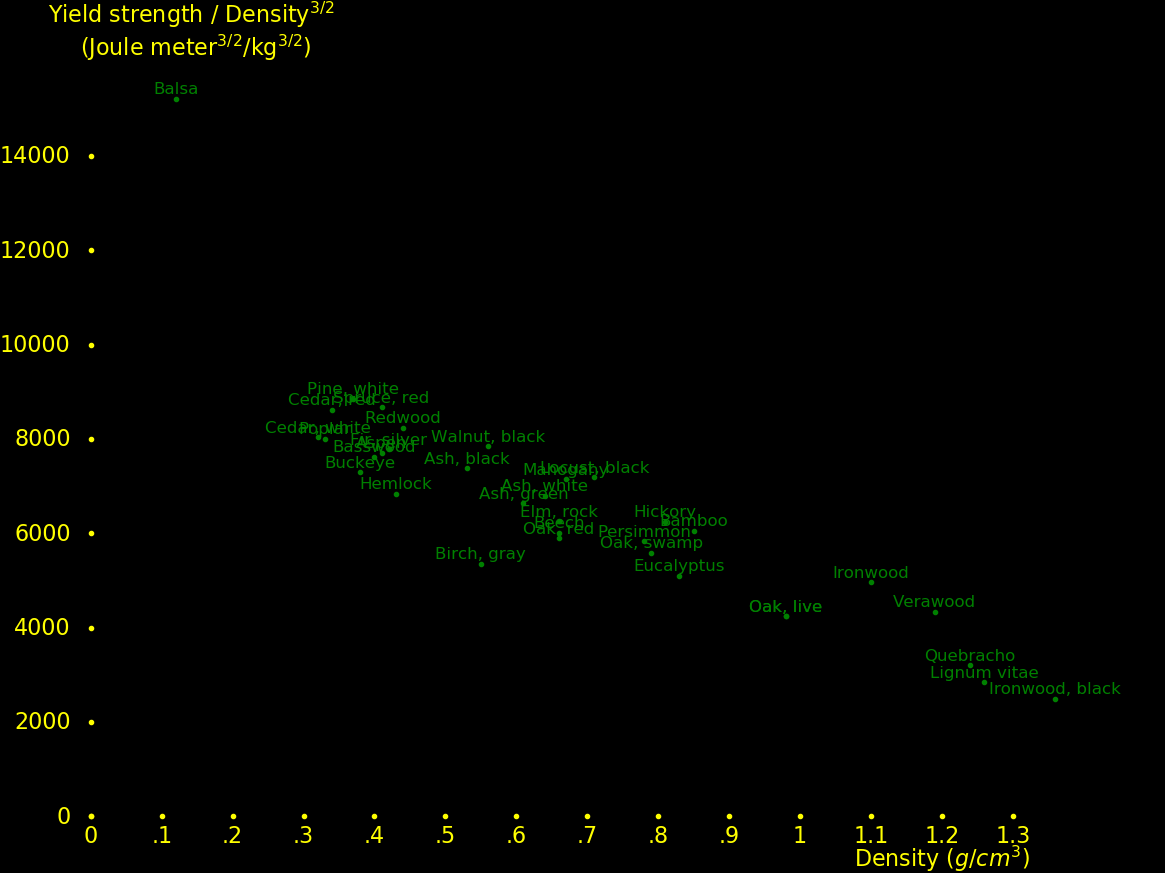 |
|---|
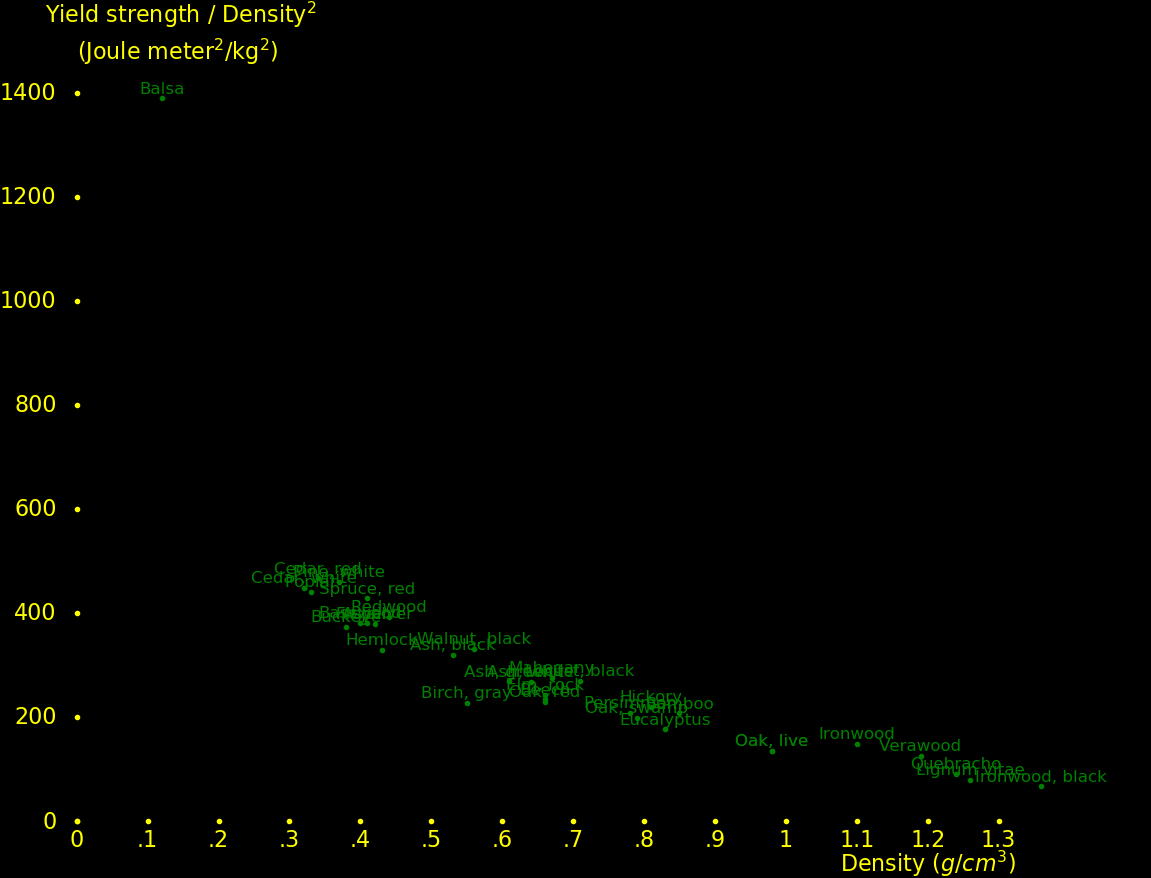 |
|---|
 |
|---|
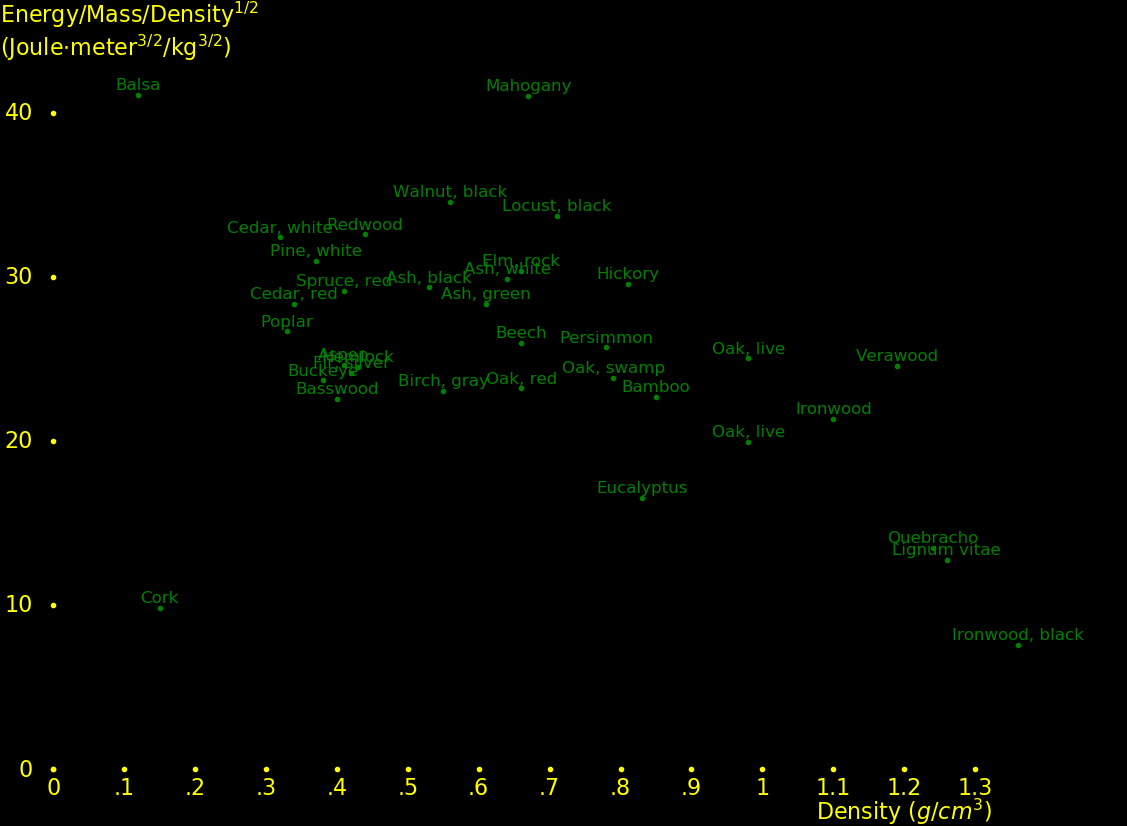 |
|---|
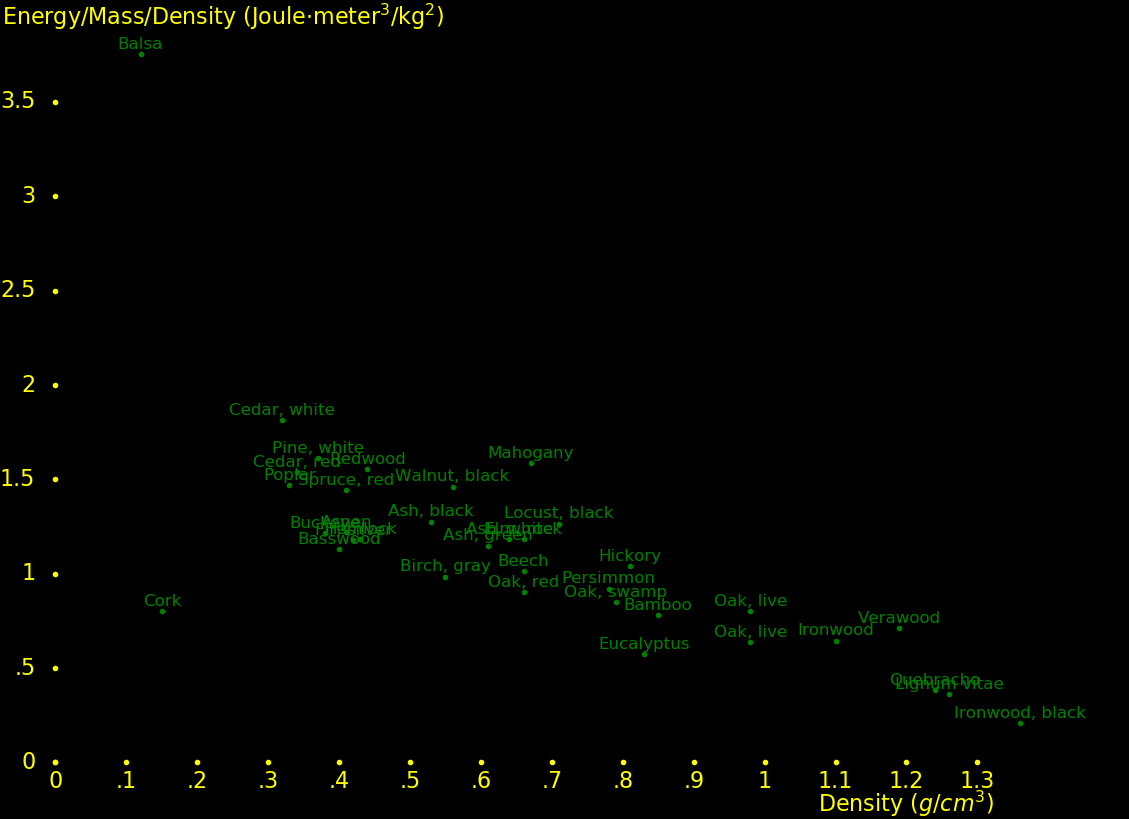 |
|---|
To compare wood to other materials,
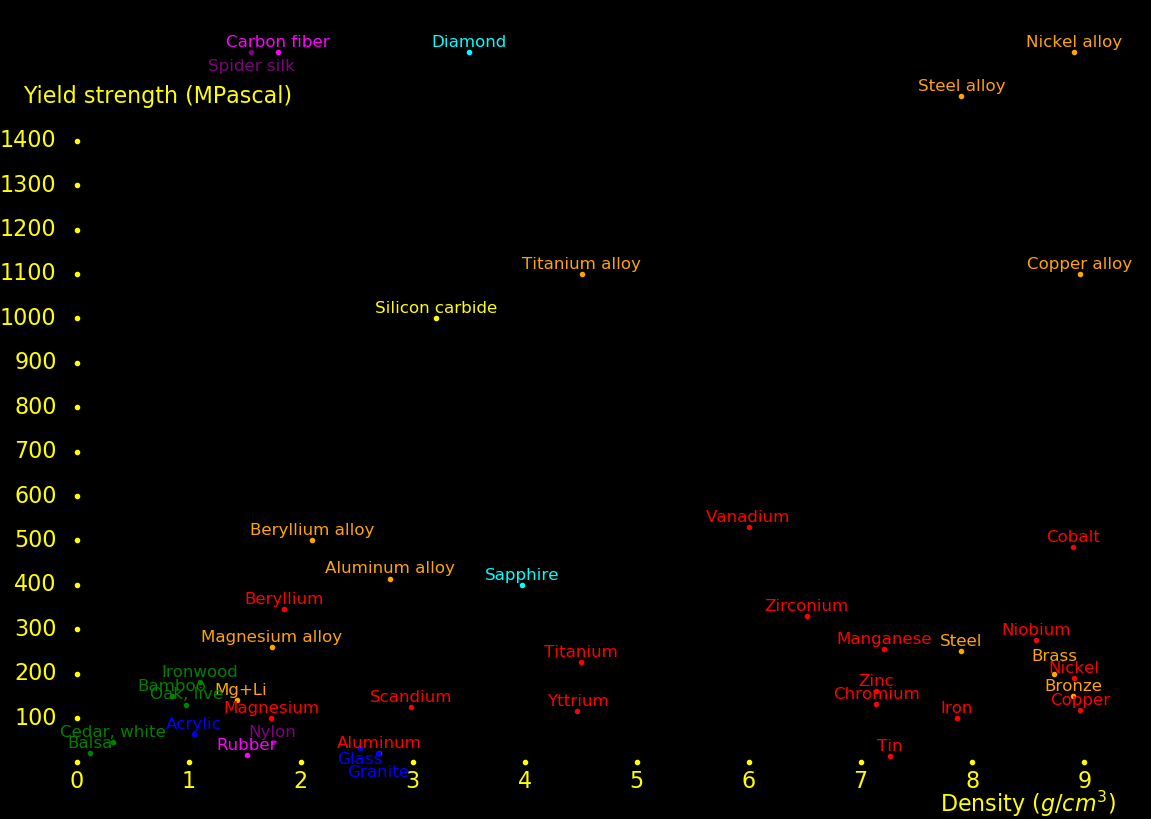 |
|---|
 |
|---|
For a vertical tree trunk, "longitudinal" is the vertical direction. "Radial" is the direction from the tree center axis, going outward in the horizonal plane. "Tangential" is the direction along a tree ring, in the horizontal plane.
Poisson numbers:
Longitudinal Radial Tangential
Wood, low density .4 .25 .2
Wood, high density .43 .35 .18
The strongest direction is the longitudinal direction and the weakest direction is the radial direction. For a beam under bending stress, you should align the longitudinal grain with the long axis of the beam, and you should align the tangential grain with the direction of the force.
 |
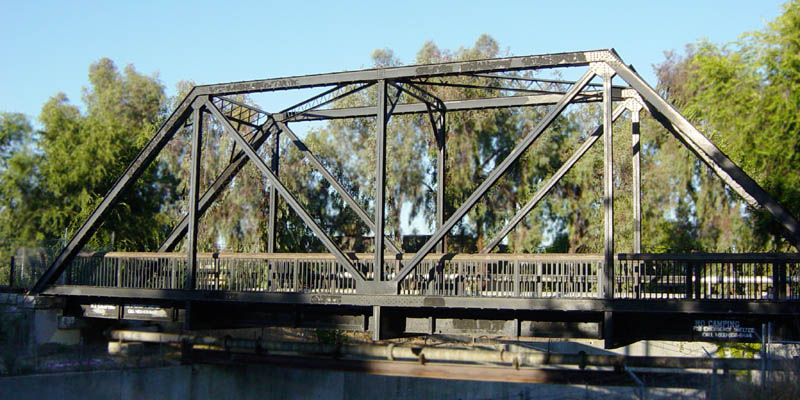 |
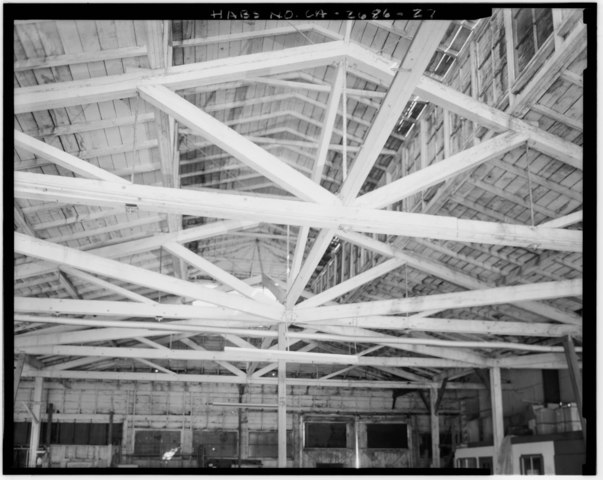 |
 |
 |
|---|---|---|---|---|
A hollow beam is weaker than a solid beam, but it has a better stength/mass ratio. This is the point of a truss. A truss consists of a set of upper and lower beams connected by struts. The struts deliver forces between the beams and they resist warp. Struts are arranged as triangles because triangles resist warp better than squares.
In a Pratt truss, diagonal beams are under tension and vertical beams are under compression.
A Howe truss is like a Pratt truss except that the diagonals slant the opposite way. In a Howe truss, diagonal beams are under compression and vertical beams are under tension.
Beams under compression should be wider than beams under tension. Compression is harder than tension.
Bridges from centuries ago tended to use wood for compression elements and steel rods for tension elements.
Triangles are stronger than squares. A structure needs triangles to resist warping.
 |
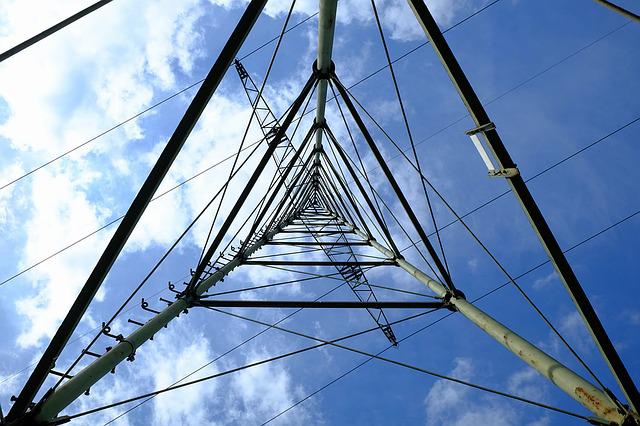 |
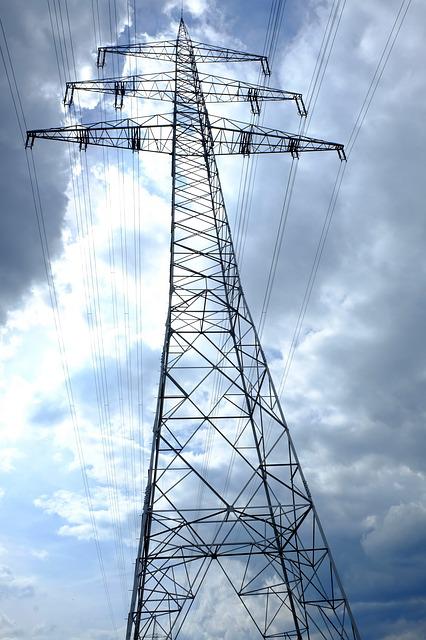 |
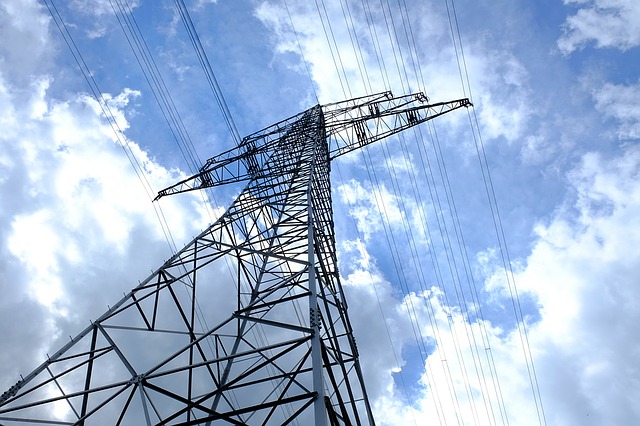 |
|---|---|---|---|
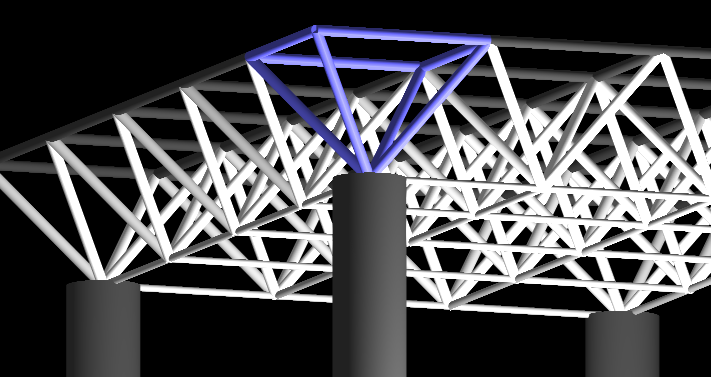 |
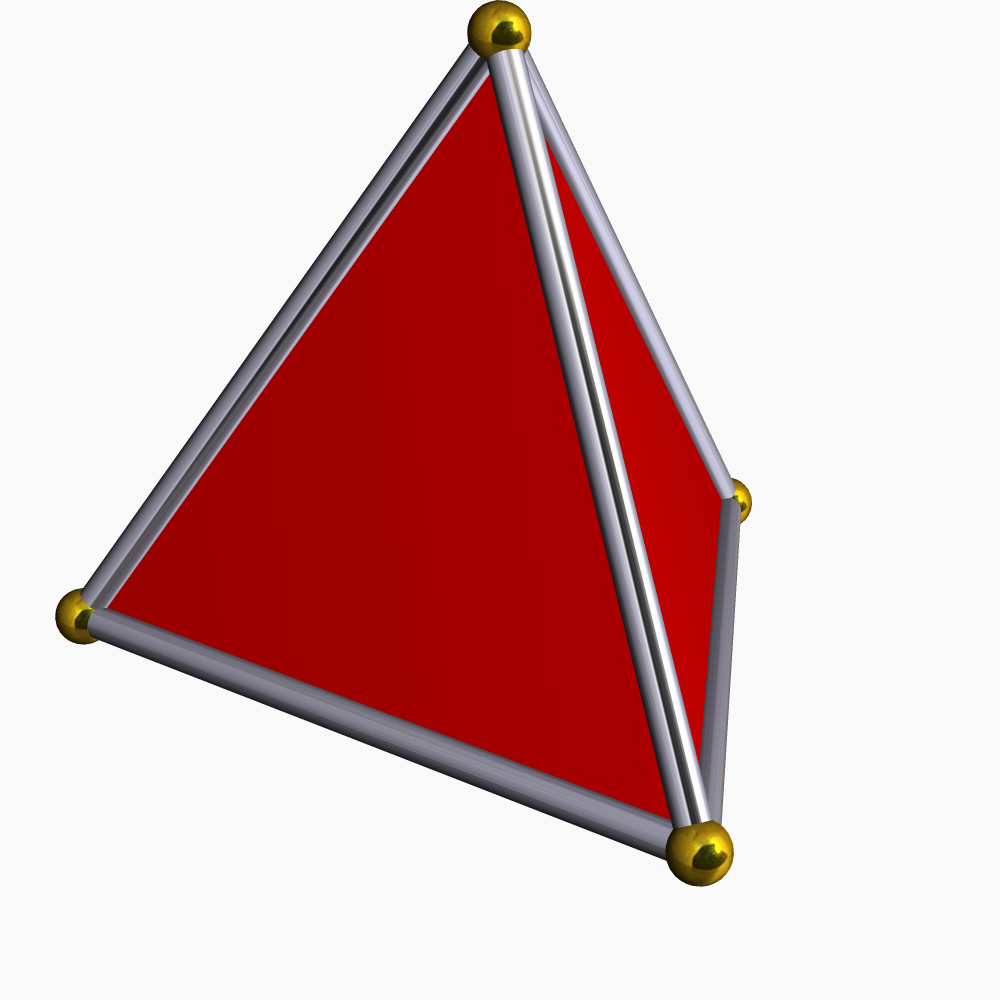 |
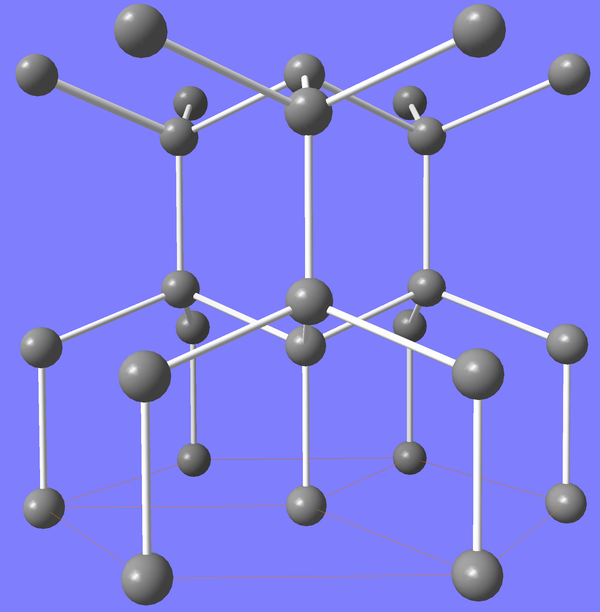 |
|---|---|---|
Tension is easy. If you can use pure tension, do it.
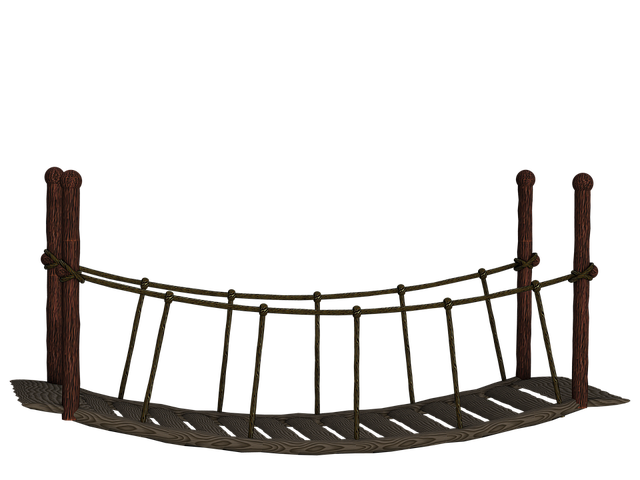 |
 |
 |
|---|---|---|
 |
 |
|---|---|
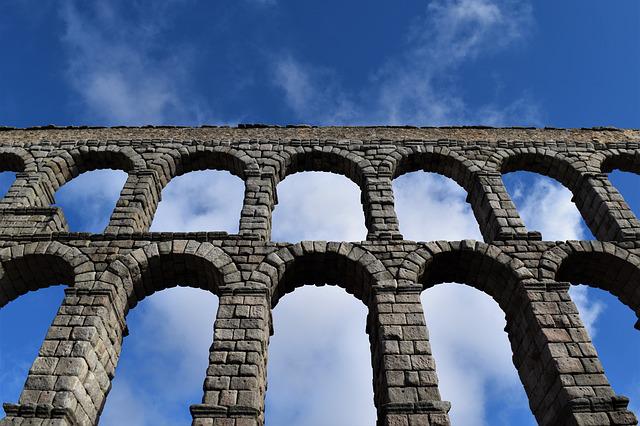 |
 |
|
|---|---|---|
A cable hangs as a catenary, and the ideal form for an arch is a catenary.
A hanging catenary transforms the load into pure tension.
An arch transforms the load into pure compression.
For a suspension bridge supporting a road, if the cable is heavier than the road, then the cable hangs as a catenary. If the road is heavier than the cable, the cable hangs as a parabola.
If you want height, use a concave catenary. If you want volume, use a convex catenary.
 |
 |
|---|---|
 |
 |
.jpg) |
 |
|---|---|---|---|
The arch can go above or below.
 |
 |
|---|---|
You can combine an arch and a truss.
 |
 |
 |
 |
 |
|---|---|---|---|---|
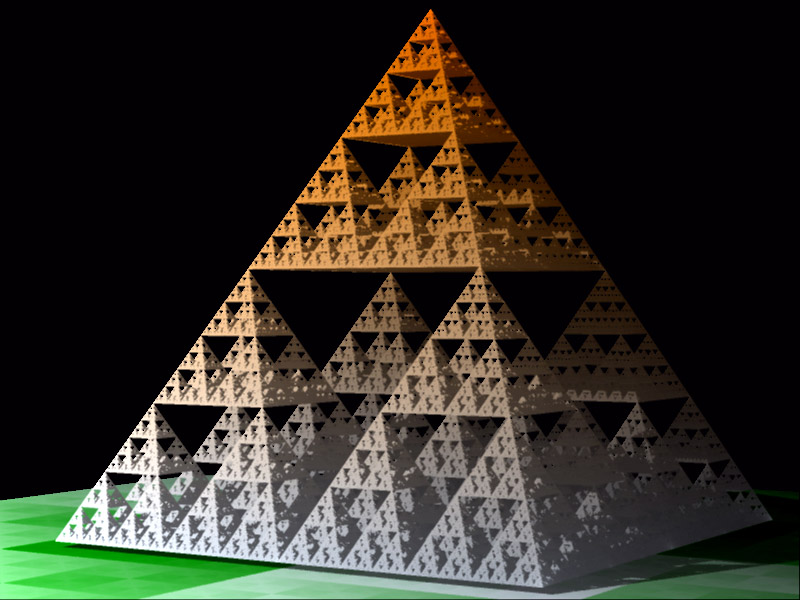 |
|---|
 |
 |
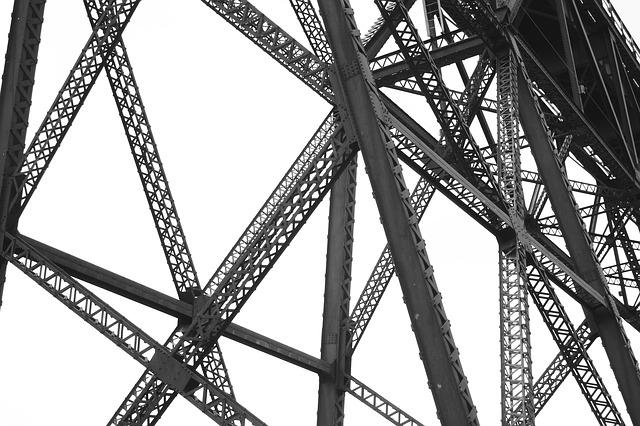 |
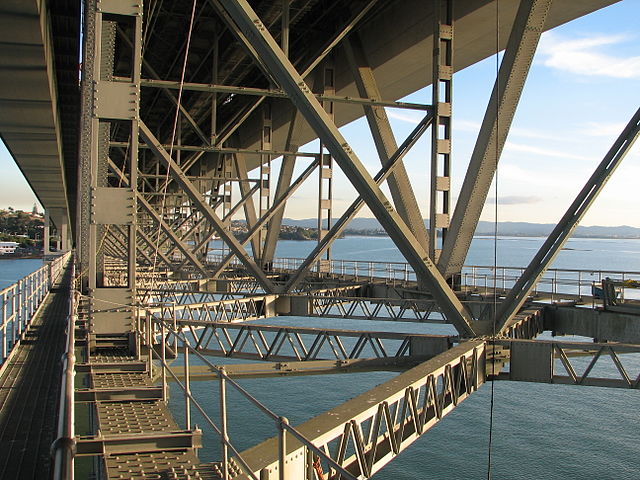 |
|---|---|---|---|
 |
 |
|---|---|
Concrete and ceramics typically have much higher compressive strengths than
tensile strengths. Concrete is typically mixed with steel bars to improve tensile
strength.
Mark Klinger has experimental results for balsa on his Youtube channel "Balsa Engineer",
which we quote.
Balsa varies widely in density, with the above quantities being averages.
The value of "s" is largely independent of density.
Strength and modulus are proportional to density.
There is an offset to the linear relationship. Strength goes to zero before density goes to zero.
It rounds out toward zero to compensate.
For many applications, what counts is tensile strength per density.
Td can be tested non-destructively while s can't. For s,
all you can do is to establish a minimum value and cull the weak material.
It would be interesting to plot s and Td to look for correlation. Density can be
indicated with color.
Imagine carving a rod from a balsa block, and also carving out neighboring rods and measuring their
yield strain "s". This may prove to be a good predictor of the yield strain of the central rod.
One could measure yield strain for the central rod and neighboring rods and do statistics on an ensemble
of central rods.
A structure function characterizes changes in a quantity as a function of change in space.
Let F(x) be a function on a 1D spatial variable x, and define its structure function S(r).
For a function F(x) on a 3D variable x, you can define a 1D structure function by making the integral over volume.
r is 1D.
r is 1D, but it can point in any direction in 3D. One can define an orthoganal set of 3 structure functions
spanning 3 dimensions. The structure functions can be aligned to coincide with the axes of the wood grain.
Balsa can be bred.
Rubber has many types, with widely-varying elastic properties.
For an aircraft motor, what matters is energy/mass, and butyl rubber does well.
For rubber, the numbers for energy/mass are estimations. To get accurate numbers,
you need to integrate the full stress-strain curve, and it's nonlinear.
The table is incomplete. Experiments are needed.
For power sources, the important qualities are energy/mass and power/mass.
Electric motors have a larger power/mass than batteries, and so the battery has more mass than
the motors.
Propellers have a larger power/mass than electric motors. For a flying vehicle, the electric motors
have more mass than the propellers.
The variables are:
For capacitors, there is a tradeoff between power/mass and energy/mass.
The key variable for flight is power/mass. Hovering flight requires an aircraft with at least
200 Watts/kg.
Density = D ~ 160 kg/meter3
Tensile strength = t ~ .027 Pascal
Tensile modulus = T ~ 4.9 Pascal
Tensile breaking strain = s = t/T = .0055 Dimensionless
Tensile modulus/density = Td ~ 31 MJoule/kg
Tensile strength/density= td ~ .169 kJoule/kg
td = s Td
S2(r) = ∫0∞ [F(r-x) - F(x)]2 dx
Tensile Density Set Cure
strength time time
MPascal gram/cm3 hour hour
Epoxy 50 1.18 5 42
Cyanoacrylate 27 1.1 .01 24
Polyvinyl acetate 25 1.19 .3 24 Elmer's glue
Polyurethane 24 1.5 18
UV glue 20 - .01
Silicone rubber 8 1.24 1 42
Rubber cement 5 1.06 .1 12
Duct tape .01 .01 .01
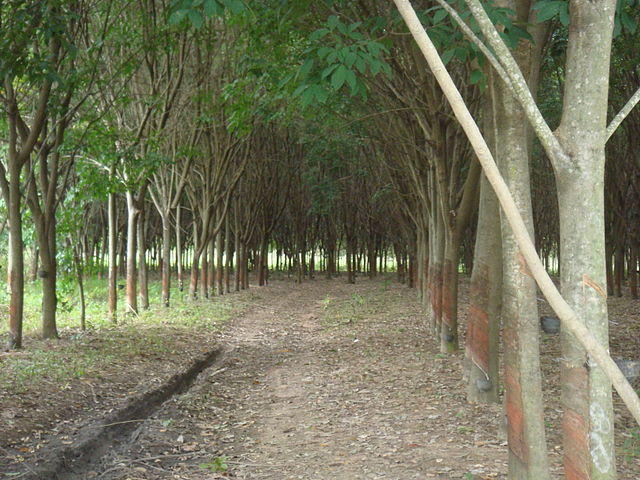
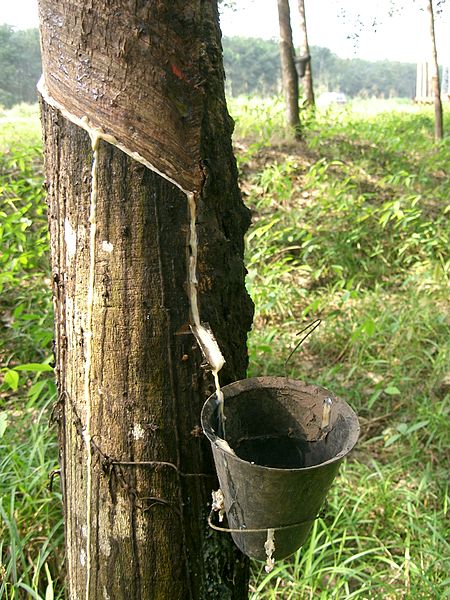



Tensile yield strength = t
Tensile modulus = Γ
Yield strain = Δ = t/Γ
Density = ρ
Elastic energy/volume = E = ½ Γ Δ2
Elastic energy/mass = e = ½ Γ Δ2 / ρ
Tensile Tensile Yield Density Tensile Common
modulus yield strain (g/cm3) energy/mass name
(GPa) (GPa) (kJoule/kg)
Rubber, butyl .007 .020 7 .92 186
Rubber, natural .003 .025 8 .92 104
Rubber, styrene .006 .0175 4.75 .94 54
Rubber, polyurethane .006 .025 3.75 1.25 34
Rubber, nitrile .004 .015 3.5 1.0 19.6
Rubber, silicone .00066 .0073 7.4 1.25 14.4
Rubber, poly .015 .005 .92
Rubber, neoprene .020 .0025 .12 1.23 1.2 Chloroprene
Cotton 15 .5 .1 1.5 50
Gut .2
Aramid 135 3 .022 1.43 22.8 Kevlar
Polyamide 5 1 .2 1.14 88 Nylon, Perlon
Polyester 15 1 .067 1.38 24
HMPE 100 2.4 .024 .97 30 Dyneema, Spectra
Vectran PBO 280 5.8 .021 1.52 41 Zylon
Vectran LCAP 65 3.8 .058 1.4 78
Vectran HT 75 3.2 .043 1.41 49
Vectran NT 52 1.1 .021 1.41 8.1
Vectran UM 103 3 .029 1.41 31
Spider silk 10 1.6 .16 1.56 82
Carbon nanorope 1050 3.6 .0034 1.34 4.5
Graphene 1050 160 .152 1.0 12000
Carbon fiber 181 1.6 .0088 1.8 3.9
Magnesium alloy 45 .26 .0058 1.74 .43
Aluminum alloy 70 .41 .0059 2.70 .45
Titanium alloy 116 1.10 .0095 4.51 1.16
Steel alloy 211 1.5 .0071 7.9 .67

Energy/Mass Power/Mass
MJoule/kg kWatts/kg
Battery, Lithium polymer 1.0 .6
Battery, Lithium ion .7 .5
Battery, Lithium titanate .3 1
Battery, Lead acid .18 .18
Battery, Aluminum air 4.6 .2 Not rechargeable
Supercapacitor .05 20
Aluminum capacitor .01 100
Gasoline motor - 5
Electric motor - 5
Propeller - 15
Electric generator - .1
Rocket, solid fuel - 5000
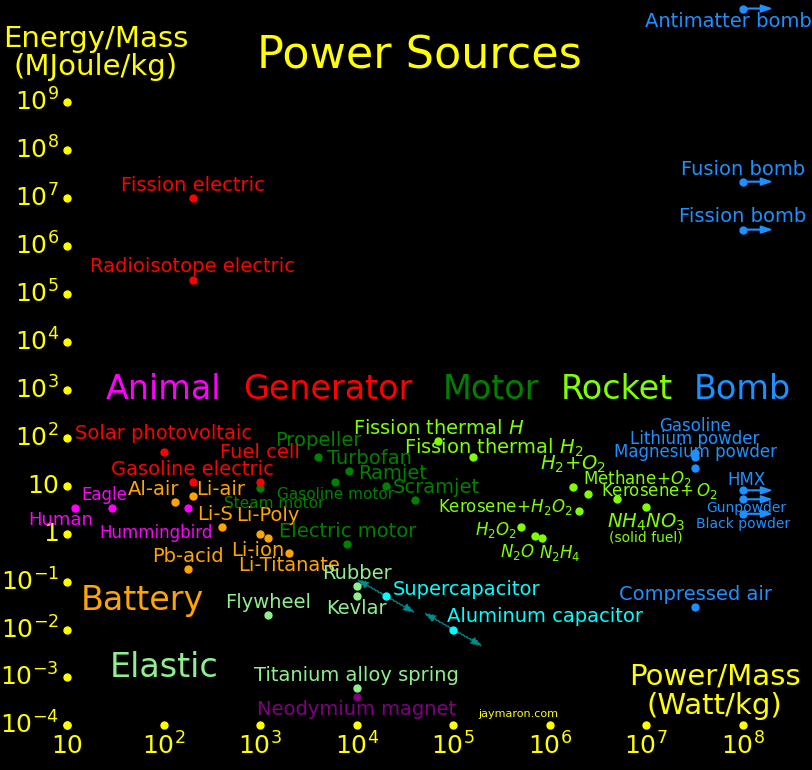
Energy/Mass = e Joules/kg
Power/Mass = p Watts/kg
Ragone number = r = e p Joule*Watt/kg2
Ragone time = t = e/p second
e p ~ 109 Joule Watt / kg2
Power/Mass Energy/Mass
Watts/kg MJoule/kg
Minimum for fixed-wing flight 100 -
Minimum for hovering flight 200 -
Battery, lithium-polymer 600 1.0
Battery, lithium-ion 800 .8
Battery, lithium-titanate 4000 .4
Electric motor 5000 -
Propeller 15000 -